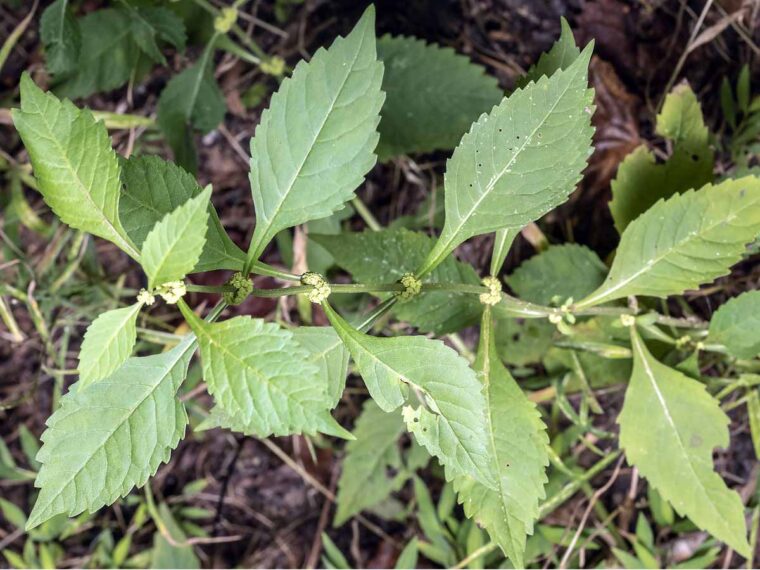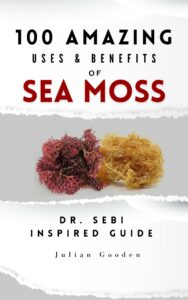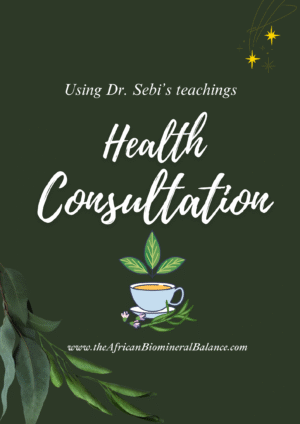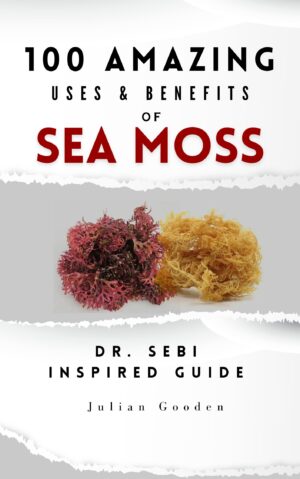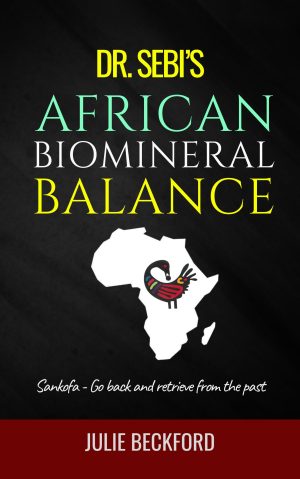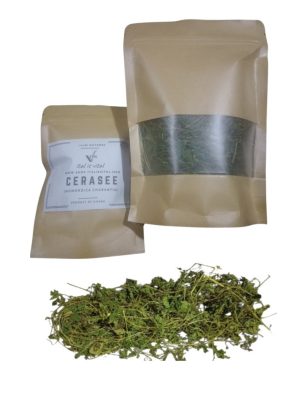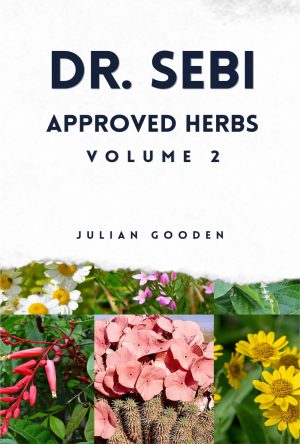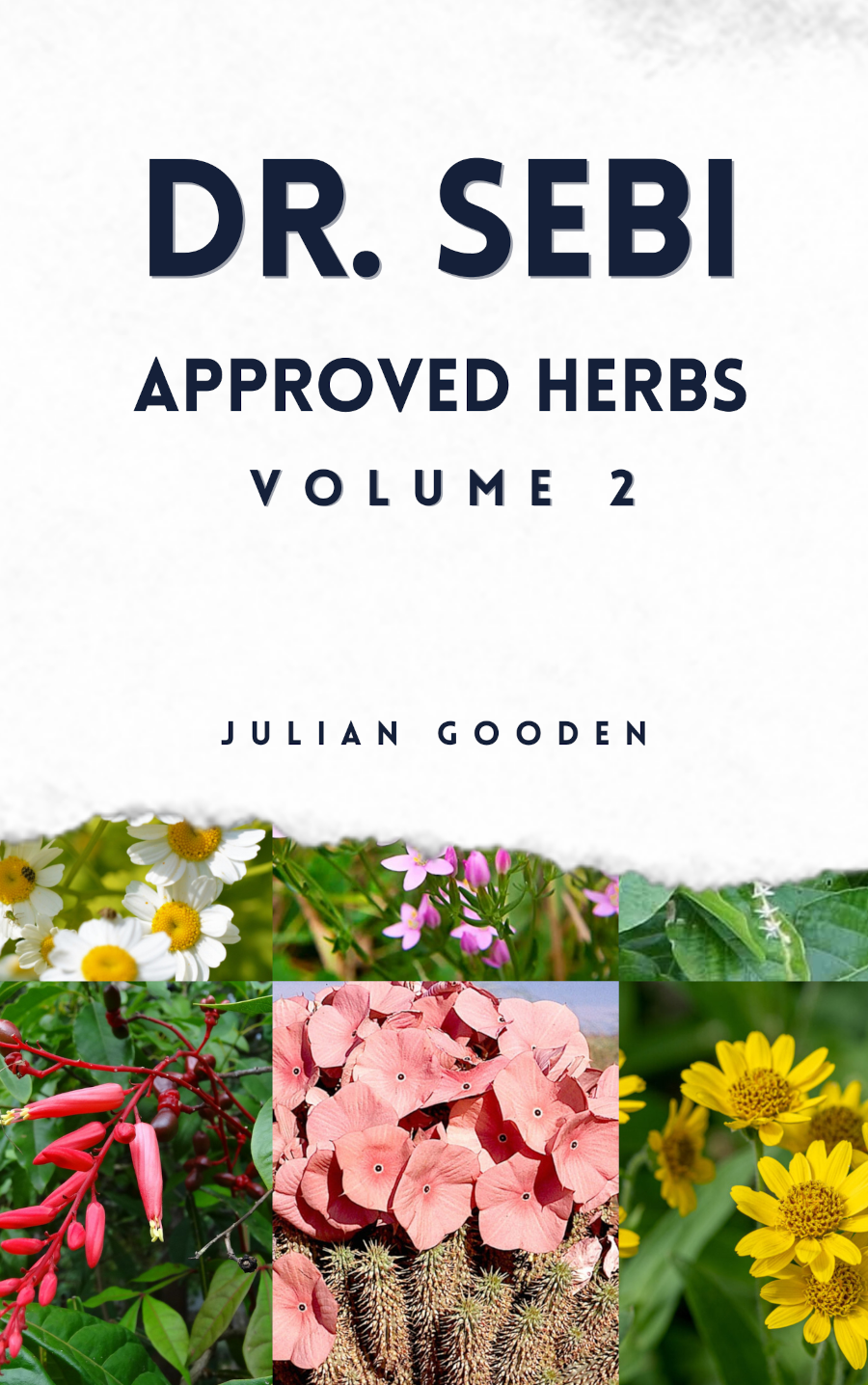Bugleweed (Lycopus virginicus L.)
Common Names Bugleweed, Virginia Bugleweed, Water Horehound, Sweet Bugle, Green Archangel, Gypsyweed, Paul’s Betony, Wolf Foot
Botanical Family Lamiaceae (Mint family)
Parts Used Aerial parts (leaves, stems, and flowers), harvested during flowering (typically late spring to early summer). Roots are occasionally used in traditional preparations but are less common.
Botanical Description Bugleweed is a low-growing, perennial herb thriving in the moist, nutrient-rich soils of North America’s damp meadows, stream banks, marshes, and woodland edges. It reaches 20-50 cm in height, occasionally taller in ideal conditions. Its square stem, a hallmark of the Lamiaceae family, is often tinged purple and slightly hairy. The opposite, lance-shaped leaves are serrated, dark green, and sometimes reddish underneath, exuding a subtle minty aroma when crushed. Small, tubular flowers-white to pale purple with delicate pink or violet spots-form dense whorls around the stem’s upper nodes, blooming from June to August. The plant’s rhizomatous roots allow it to spread modestly, forming clumps in wet environments. Bugleweed’s preference for waterlogged soils reflects its ecological role in stabilizing wetland ecosystems and supporting pollinators like bees and small flies.
Ecological Role Bugleweed is a keystone species in wetland habitats, preventing soil erosion along stream banks and providing nectar for native pollinators. Its ability to thrive in saturated soils makes it a candidate for ecological restoration projects. It often grows alongside other water-loving herbs like skullcap (Scutellaria lateriflora) and water mint (Mentha aquatica), forming part of a vibrant, moisture-rich plant community.
Energetic & Holistic Profile (Dr. Sebi–Inspired View) Dr. Sebi, a proponent of “natural vegetation cell food,” championed plants that restore the body’s electric and mineral balance. Bugleweed aligns with this teachings through its:
- Affinity for water-rich environments, symbolizing purification, fluidity, and conductivity in the body’s systems.
- Regulating action, calming overactive states (e.g., racing heart, hyperthyroid activity, or nervous agitation) rather than stimulating deficient ones.
- Mineral-rich composition, including trace elements like manganese and calcium, which support cellular integrity, nerve function, and circulatory rhythm.
Dr. Sebi highlighted its positive effect on the heart. Bugleweed is viewed as a “heart regulator” and a harmonizer of the body’s electrical impulses. He believed it helped clear “toxic obstructions” that disrupt natural rhythms, restoring calmness and oxygenation to the blood. Its role in soothing hyperactive states aligns with Dr. Sebi’s emphasis on alkaline, plant remedies that promote balance without overstimulating the system.
Primary Actions and Uses
- Cardiovascular Support
- Mild cardiac sedative: Bugleweed slows excessive heart rates (tachycardia) and eases palpitations, particularly when triggered by stress, anxiety, or thyroid overstimulation.
- Vascular tone regulator: Its astringent tannins strengthen capillaries and improve microcirculation, reducing fragility without elevating blood pressure.
- Fluid balance: Acts as a gentle diuretic, aiding in the elimination of excess fluid, which can relieve pressure on the heart and lungs. This is particularly helpful for edema or congestive conditions.
- Dr. Sebi Context: He emphasized Bugleweed’s ability to “cool the heart’s fire,” addressing overactivity caused by toxic buildup or nervous imbalance rather than structural deficiencies.
- Thyroid Modulator
- Bugleweed is renowned for its antithyrotropic properties, reducing thyroxine (T4) production and thyroid-stimulating hormone (TSH) activity.
- Effective for hyperthyroidism, Graves’ disease, and associated symptoms like anxiety, tremors, weight loss, and insomnia.
- Its phenolic compounds(e.g., lithospermic compound) inhibit TSH binding to thyroid receptors and block the conversion of T4 to T3, providing a natural counterbalance to thyroid overactivity.
- Often paired with lemon balm (Melissa officinalis) for its calming synergy and motherwort (Leonurus cardiaca) for heart-thyroid synergy.
- Nervous System Calming
- As a mild nervine, Bugleweed soothes anxiety, restlessness, and nervous tension, particularly when these manifest physically as rapid pulse, sweating, or insomnia.
- Useful for “overcharged” states where stress amplifies physical symptoms, such as in panic attacks or stress-induced palpitations.
- Its calming effect complements its thyroid-regulating action, addressing the nervous system’s role in hyperthyroid symptoms.
- Respiratory & Lymphatic System
- Traditionally used for congestive respiratory issues, including wet coughs, bronchitis, and mild asthma, due to its ability to reduce mucus and promote expectoration.
- Supports lymphatic drainage, clearing stagnation and mild inflammation, which aids detoxification.
- Its diuretic and lymphatic actions make it valuable for conditions involving fluid retention or sluggish lymph flow.
- Menstrual and Hormonal Regulation
- Bugleweed’s astringent properties help reduce excessive menstrual bleeding (menorrhagia) by toning uterine tissues.
- Its mild anti-gonadotropic effects may ease premenstrual tension, especially when linked to thyroid imbalances or nervous irritability.
- Useful for women experiencing heavy periods or hormonal fluctuations tied to stress or hyperthyroidism.
- Additional Uses
- Wound healing: Historically applied topically as a poultice for minor cuts or bruises due to its astringent and anti-inflammatory properties.
- Digestive support: In small doses, it can ease mild digestive upset caused by nervous tension, though this is a secondary use.
- Sleep aid: When combined with other nervines like valerian or lemon balm, it promotes restful sleep in cases of insomnia linked to hyperthyroidism or anxiety.
Constituents
- Phenolic compounds: Lithospermic, rosmarinic, and caffeic compounds (anti-inflammatory, antioxidant, thyroid-regulating).
- Flavonoids: Luteolin, apigenin derivatives (antioxidant, calming, vascular support).
- Tannins: Astringent compounds that tone tissues and reduce excess fluid.
- Volatile oils: Trace amounts, contributing to its mild minty aroma but less pronounced than in other Lamiaceae plants.
- Glycosides and triterpenoids: Stabilizing and anti-inflammatory agents that support overall cellular health.
- Minerals: Trace amounts of manganese, calcium, and magnesium, aligning with Dr. Sebi’s focus on mineral-rich plants for cellular repair.
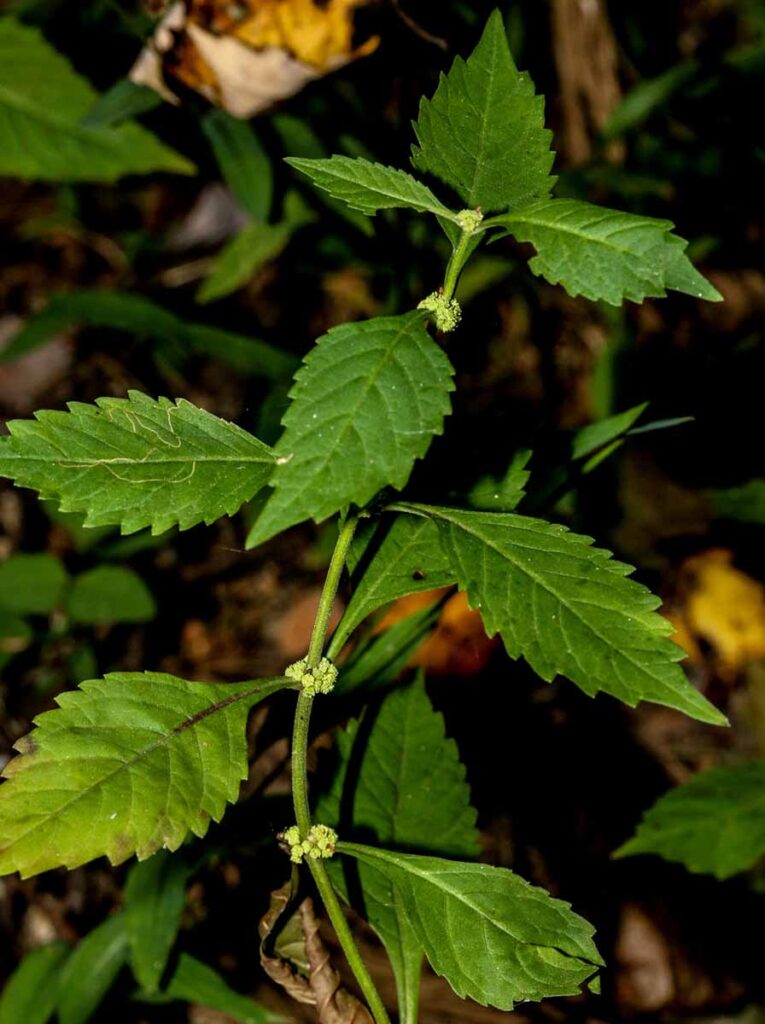
Traditional & Ethnobotanical Uses
- Native American Medicine: Tribes such as the Cherokee and Iroquois used Bugleweed to slow rapid heart rates, ease coughs, and promote calmness. It was often prepared as a tea or poultice for respiratory and cardiovascular complaints.
- Early American Herbalism: Valued as a heart tonic and remedy for “nervous excitement,” Bugleweed was a staple in colonial apothecaries for palpitations and anxiety.
- Eclectic Physicians (19th Century): Recommended Bugleweed for Graves’ disease, excessive bleeding (e.g., hemoptysis, menorrhagia), and “irritable heart syndrome” (a historical term for stress-induced cardiac symptoms).
- European Traditions: Though less common in Europe, related species (Lycopus europaeus) were used similarly for thyroid and heart conditions, reflecting shared Lamiaceae properties.
- Dr. Sebi’s Legacy: He incorporated Bugleweed into his protocols for heart and thyroid health, emphasizing its role in restoring rhythm and clearing “acidic” states caused by poor diet or stress.
Historical Anecdote In the 19th century, Eclectic physician Dr. John King noted Bugleweed’s efficacy in treating “palpitations of the heart from nervous causes” and its ability to “lessen the frequency of the pulse without reducing its force.” This aligns with modern uses for stress-related tachycardia and highlights Bugleweed’s long-standing reputation as a gentle yet effective regulator.
Preparation & Dosage Bugleweed’s gentle action requires consistent, low doses for optimal results. Overuse can overly suppress thyroid or cardiac function.
Forms:
- Infusion (Tea): Preferred for its gentle delivery and alignment with traditional uses.
- Tincture: Concentrated and convenient for precise dosing.
- Fluid Extract or Capsules: Less common but available in modern herbalism.
- Poultice: Fresh or dried herb mashed with water for topical use (e.g., bruises or minor wounds).
Infusion:
- 1-2 teaspoons of dried aerial parts per cup (240 ml) of hot water (just below boiling, ~190°F/88°C).
- Steep covered for 10-15 minutes to preserve volatile compounds.
- Drink 1-3 cups daily, depending on severity of symptoms. Best taken between meals for absorption.
Tincture:
- 1-2 ml (20-40 drops) in water, 2-3 times daily.
- Dilute in a small amount of water or juice to improve palatability.
Poultice:
- Crush fresh leaves or rehydrate dried herb with warm water to form a paste.
- Apply to minor cuts, bruises, or swollen areas for 20-30 minutes, 1-2 times daily.
Note: Start with lower doses and monitor effects, especially for thyroid or heart conditions. Bugleweed’s effects are cumulative, so consistent small doses are more effective than large, sporadic ones.
Cautions & Contraindications
- Hypothyroidism: Avoid use, as Bugleweed suppresses thyroid function and may exacerbate low thyroid activity.
- Pregnancy and Lactation: Contraindicated due to potential anti-gonadotropic effects and lack of safety data.
- Thyroid Medications: May interfere with levothyroxine or other thyroid drugs; consult a healthcare provider.
- Cardiac Medications: Use cautiously with beta-blockers or other heart rate-lowering drugs, as Bugleweed’s sedative effects may amplify them.
- Allergies: Rare, but those with Lamiaceae sensitivities (e.g., to mint or oregano) should test small amounts first.
- Long-Term Use: Limit to 6-8 weeks unless under professional supervision, as prolonged use may overly suppress thyroid function.
Dr. Sebi Perspective Summary From a Bio-mineral Balance perspective, Bugleweed:
- Electrifies the circulatory system, enhancing mineral transport to cells and tissues.
- Soothes nerve impulses, reducing erratic signals that cause palpitations or tremors.
- Restores oxygenation and harmony, aligning with Dr. Sebi’s view of blood as the medium of life’s electrical flow.
- Clears stagnation, supporting detoxification through its diuretic and lymphatic actions.
Bugleweed’s role as a subtle, grounding herb makes it a cornerstone for calming overactive systems, promoting an “alkaline, electric body” in balance.
Energetic & Spiritual Insight Bugleweed resonates with the heart chakra (Anahata), the energetic center of love, balance, and connection. Its cooling, stabilizing nature helps those who “run hot”—physically (hyperthyroidism, palpitations), emotionally (anxiety, irritability), or spiritually (overwhelm, disconnection). In vibrational healing, Bugleweed restores rhythm across these planes:
- Physically: Regulates heartbeat and thyroid function.
- Emotionally: Promotes calm and emotional resilience.
- Spiritually: Fosters peace and alignment with one’s natural flow.
Its water-loving growth reflects its ability to “flow” through stagnation, making it ideal for those under chronic stress or pressure. In meditation or ritual, Bugleweed can be used to ground and center, often paired with heart-opening practices or affirmations of balance.
Complementary Herbs
- Motherwort (Leonurus cardiaca): Emotional heart tonic, eases anxiety-driven palpitations.
- Hawthorn (Crataegus spp.): Strengthens heart structure and improves circulation.
- Lemon Balm (Melissa officinalis): Calms thyroid and nervous system, enhances Bugleweed’s effects.
- Sarsaparilla (Smilax spp.): Blood purifier and mineralizer, supports detoxification.
- Irish Moss (Chondrus crispus): Provides minerals for tissue repair and cellular health.
- Skullcap (Scutellaria lateriflora): Deepens nervous system relaxation, especially for insomnia.
Modern Research Insights Recent studies validate Bugleweed’s traditional uses:
- A 2013 study in Phytotherapy Research confirmed lithospermic “acid’s” role in inhibiting TSH binding, supporting its use in hyperthyroidism.
- Research in Journal of Ethnopharmacology (2018) highlighted its flavonoid content for cardiovascular benefits, particularly in reducing oxidative stress in blood vessels.
- Clinical observations suggest Bugleweed’s efficacy in managing mild hyperthyroid symptoms, though more robust trials are needed.
Its low toxicity profile makes it a safe option for short-term use under guidance, but its thyroid-suppressing effects underscore the need for caution in hypothyroidism or with thyroid medications.
References
- Hoffmann, D. Medical Herbalism. Healing Arts Press, 2003.
- Chevallier, A. Encyclopedia of Herbal Medicine. DK Publishing, 2016.
- Mills, S. & Bone, K. Principles and Practice of Phytotherapy. Churchill Livingstone, 2013.
- Felter, H.W. & Lloyd, J.U. King’s American Dispensatory. 1898.
- Dr. Sebi, Lecture Archives – “Heart and the Natural Electric System of the Body.”
- Newall, C.A. et al. Herbal Medicines: A Guide for Healthcare Professionals. Pharmaceutical Press, 1996.
- Bone, K. A Clinical Guide to Blending Liquid Herbs. Churchill Livingstone, 2003.
- Wood, M. The Earthwise Herbal: A Complete Guide to New World Medicinal Plants. North Atlantic Books, 2009.


